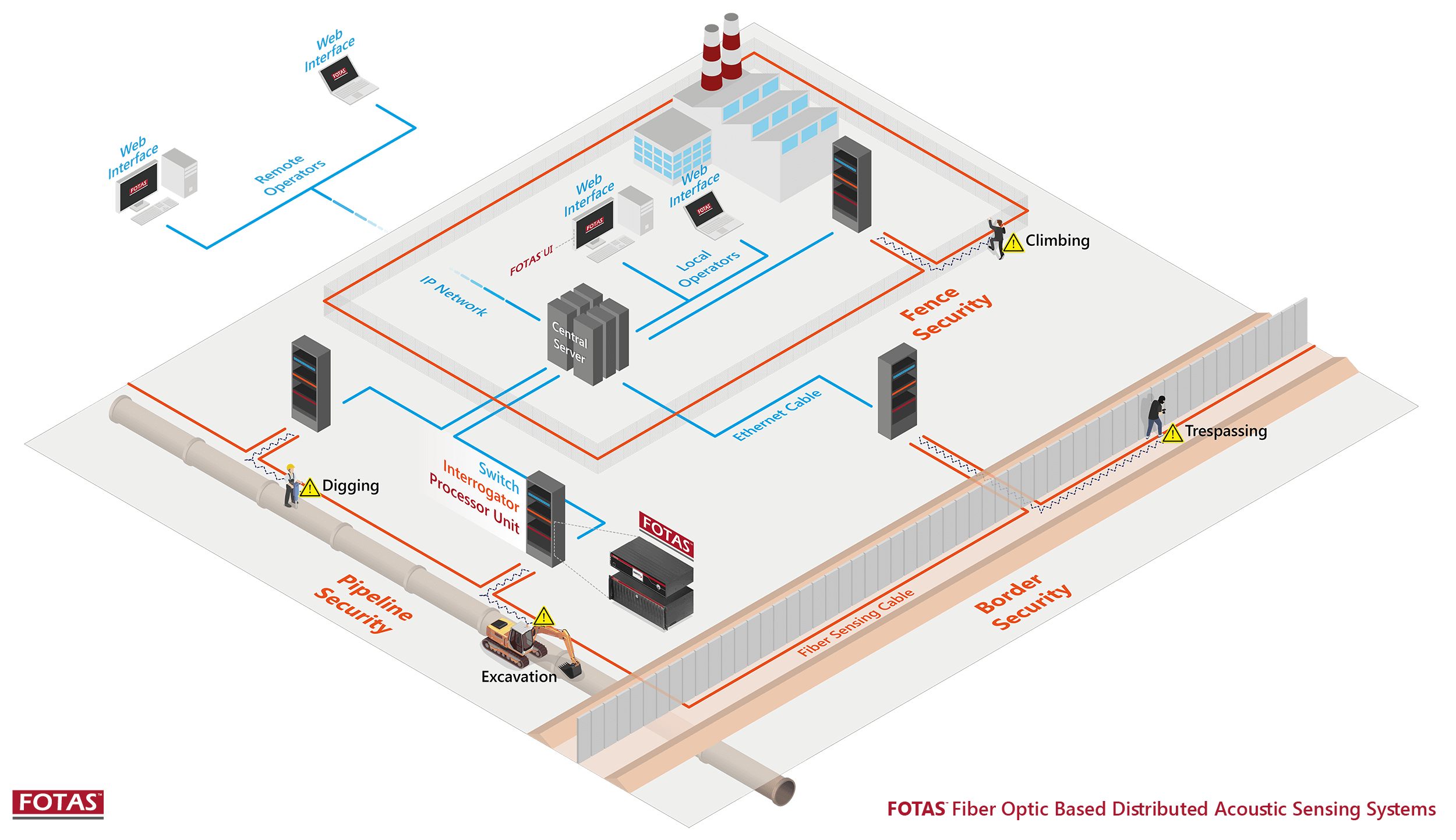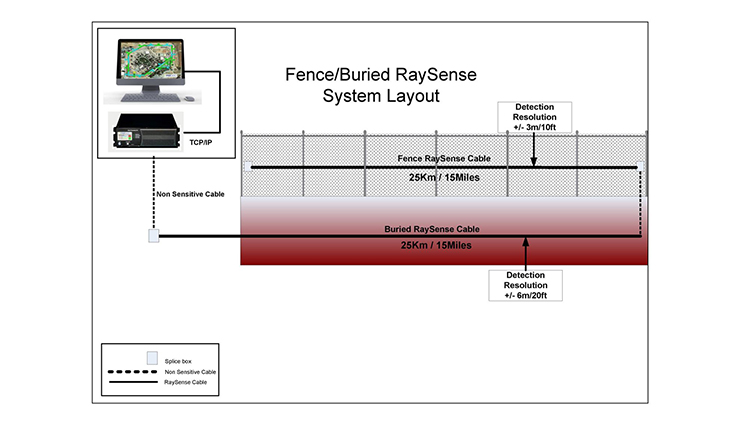The Value of a Fiber Optic Security System in Protecting Sensitive Data and Areas
The Value of a Fiber Optic Security System in Protecting Sensitive Data and Areas
Blog Article
Why Fiber Optic Safety And Security Solutions Are the Future of Security
The change to fiber optic protection systems marks a significant advancement in the realm of defense, driven by their outstanding information transmission capacities and strength to exterior disturbances. As the landscape of safety develops along with emerging technologies such as AI and IoT, the potential for fiber optics to improve and redefine security frameworks comes to be progressively apparent.
Advantages of Fiber Optic Equipments
Among the main advantages of fiber optic systems is their exceptional bandwidth ability, which promotes the transmission of big quantities of information over long ranges without substantial loss. This particular is particularly helpful for safety applications that need the continual monitoring and transfer of high-definition video clip feeds, sensor information, and other critical info. Fiber optics can accommodate the expanding needs of contemporary safety systems, guaranteeing that information remains undamaged and trusted.
In addition, fiber optic cords are less vulnerable to electro-magnetic interference, which can be a considerable concern in environments with different electronic gadgets. This resistance enhances the honesty of the data being sent, thus minimizing the risk of data violations or system failings. Fiber optic systems are inherently much more safe and secure than typical copper cables, as tapping right into a fiber optic line without discovery is exceptionally difficult.
The longevity of fiber optic cable televisions likewise adds to their appeal. They are immune to ecological factors such as moisture and temperature changes, lowering upkeep expenses and raising system longevity. On the whole, these benefits position fiber optic systems as a robust and reliable option for modern-day safety and security infrastructures, guaranteeing reliable and protected data transmission.
Improved Data Transmission Rate

The capacity to transfer vast amounts of information promptly promotes the smooth integration of high-def video clip feeds and progressed analytics. Protection systems can now refine and assess information in real-time, enhancing response times and situational awareness. Furthermore, fiber optic links support longer transmission distances without degradation of signal high quality, making them ideal for expansive safety networks.
The boosted rate of fiber optic systems not only improves the efficiency of security operations yet likewise minimizes latency. This is especially essential in critical situations where timely decision-making can protect against safety breaches or reduce potential dangers. As companies continue to prioritize safety and security and performance, the need for quick and reliable information transmission will most certainly strengthen fiber optic systems as a cornerstone of modern-day safety infrastructure.
Resistance to Interference
Fiber optic safety and security systems consistently show outstanding resistance to electromagnetic interference, an important benefit in atmospheres prone to electronic noise. Unlike typical copper cable televisions, which can be adversely affected by magnetic fields, superhigh frequency disturbance, and other types of electrical disruption, fiber optic cables make use of light to transmit data. This inherent property guarantees that the signals remain clear and unchanged, no matter bordering electronic task.
Using glass or plastic fibers in fiber optic about his innovation creates a barrier against interference, permitting for dependable data transmission even in difficult scenarios such as commercial centers, metropolitan locations with high digital website traffic, or locations near radio towers. This particular significantly reduces the probability of signal degradation or loss, making fiber optic systems especially appropriate for protection applications where integrity and accuracy of data are extremely important.
Moreover, this resistance to interference enhances the overall efficiency and dependability of safety systems, making certain that monitoring and alert systems function effortlessly. In a globe where security is significantly threatened by advanced modern technologies, the durability of fiber optic systems attracts attention as a pivotal function, reinforcing their status as a necessary part of contemporary safety facilities.
Cost-Effectiveness Gradually
Significant expense savings can be achieved with time with the implementation of fiber optic security systems. While the first financial investment might seem greater compared to conventional copper-based systems, the long-lasting economic benefits emerge via decreased operational and maintenance expenses (fiber security). Fiber optic cables are naturally extra long lasting and less susceptible to environmental aspects, which translates to lower substitute and fixing expenses over their lifespan
Moreover, fiber optic systems call for less power to run, which additionally decreases power prices. Boosted data transmission capacities enable less repeaters and amplifiers, minimizing tools investment and enhancing installation processes. The scalability of these systems additionally adds to cost-effectiveness, as organizations can broaden their protection framework without incurring considerable added expenditures.
Another aspect to take into consideration is the raised efficiency in tracking and reaction abilities that optical fiber provide. Improved real-time data transmission can result in quicker occurrence feedback times, potentially mitigating losses and responsibilities related to safety violations. In amount, the long-term advantages of fiber optic safety systems not only justify the first expense however additionally place them as a monetarily prudent selection for organizations looking for durable protection options.

Future Advancements in Security
Advancing innovations are readied to transform protection systems, integrating synthetic intelligence (AI) and artificial intelligence to boost risk discovery and feedback abilities. These innovations will enable safety and security systems to assess vast quantities of information in real-time, identifying patterns and abnormalities that indicate prospective hazards. This aggressive approach will enable quicker decision-making and extra reliable case actions.
Furthermore, the unification of the Net visit our website of Things (IoT) is leading the way for interconnected safety devices, providing detailed monitoring and surveillance. Smart sensing units can pass on info about environmental adjustments, while automated signals can inform protection employees quickly of suspicious tasks.
Furthermore, the development of biometric technologies will certainly additionally reinforce safety devices. Facial acknowledgment, fingerprint scanning, and retina recognition are ending up being much more advanced, providing layers of authentication that are tough to bypass.
Final Thought
To conclude, fiber optic security systems stand for a substantial development in protection modern technology, providing unequaled data transmission rate, resistance to electro-magnetic interference, and lasting cost-effectiveness. As the demand go to this site for sophisticated safety and security services remains to grow, the integration of optical fiber with emerging modern technologies such as AI, IoT, and biometrics will additionally improve security facilities (fiber security). The mix of these advancements will make sure a more protected and receptive atmosphere, strengthening fiber optics as a foundation of future protection systems
Report this page